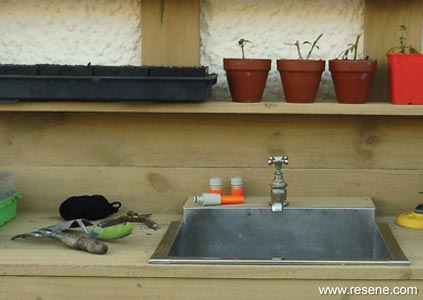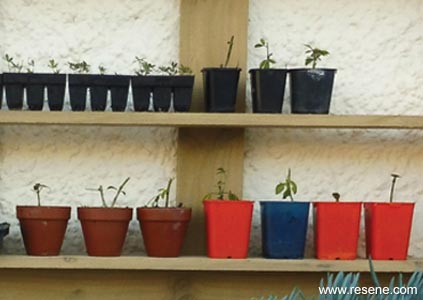Potting bench
Treat yourself in time for spring and construct this useful potting bench with built-in sink and tap – perfect for sowing seeds and taking cuttings for the new growing season ahead.
You will need: 1800mm fence palings (x20), 75mm x 100mm x 1800mm fence posts (x2), 20mm hose connector, 75mm exterior screws, circular saw (for cutting sink hole in bench top), drill with 10mm drill bit (for starting holes cut by the jigsaw), garden hose with clip on connector, hand saw, jigsaw (for cutting holes to fit tap), large bath tap with 20mm threaded connector, laundry tub with waste pipe, large plastic bin for collecting waste water, paintbrush, pencil , Resene Woodsman tinted to Resene Uluru, sandpaper, saw, screwdriver, set square, spanner, tape measure, turps for washing brush.
Top tip: The lower shelf is intended for storing lighter objects only, such as empty plant pots. Avoid storing heavier objects here (such as bags of potting mix).
Handy hint: When cutting a hole in a piece of wood with a jigsaw always mark the pattern first with a pencil outline and drill a 10mm hole within this. You can then position the jigsaw blade through this hole to begin the cut.
To get the look: Mark painted the watering can with Resene Lumbersider tinted to Resene Spritzer.
Here's another idea: If you’re intending to build a DIY greenhouse, consider saving a bit of time and expense by incorporating this bench into one wall of the structure – simply fill in the back with fence palings or glaze the back openings with the same material as the greenhouse.

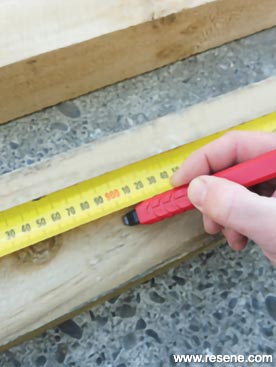 Step one
Step one
Measure, mark and cut the two fence posts in half and then measure, mark and cut two of the fence palings into three equal lengths (totaling six pieces). Smooth any rough edges with sandpaper.
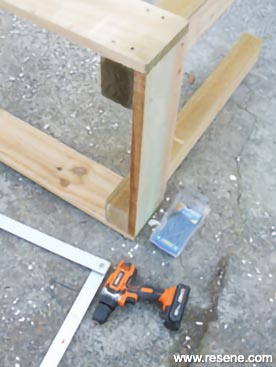 Step two
Step two
On a flat surface, attach two of the shorter pieces of fence paling and two full fence palings to the four lengths of fence post, as shown (to form the legs and main support frame of the potting bench). Fix with 75mm exterior screws and use the set square to ensure legs are at ninety degrees on each side.
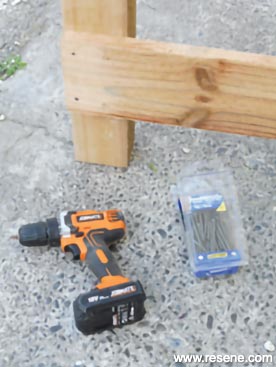 Step three
Step three
Attach two more of the shorter lengths of fence paling to the sides of the main support frame (approx 320mm up from the base of each leg). Again, fix with 75mm screws.
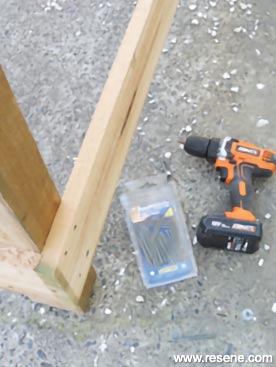 Step four
Step four
Attach one full fence paling along the back of the main support frame (again, approx 320mm up from the base of both legs), fixing with 75mm screws.
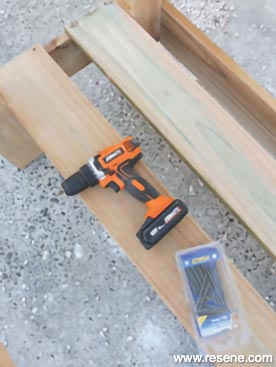 Step five
Step five
Create a lower shelf, as shown, using two full fence palings. Fix at each end with 75mm screws.
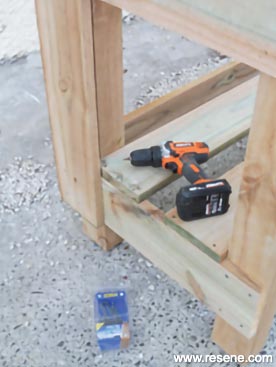 Step six
Step six
Attach two full fence palings vertically, as shown, at the back corners of the potting bench, fixing with 75mm screws.
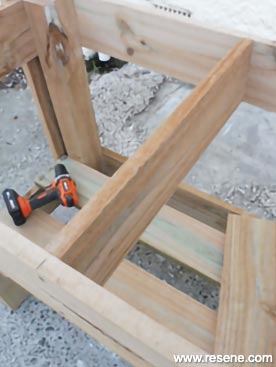 Step seven
Step seven
Attach the two remaining shorter lengths of fence paling to form cross supports for the bench top, as shown, ensuring they are spaced far enough apart to fit the central sink comfortably between). Fix with 75mm screws.
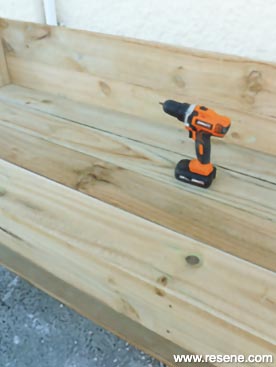 Step eight
Step eight
Attach two full fence palings along the back of the potting bench to form a splash back, and then, working from the back forwards, attach five full fence palings to form the bench top. Fix with 75mm screws.
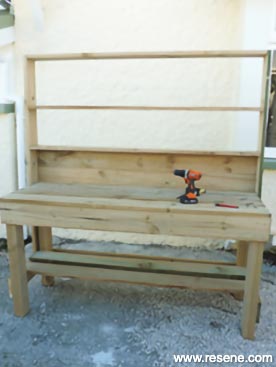 Step nine
Step nine
Attach three full fence palings horizontally to form the shelves along the back of the potting bench, as shown. Fix with 75mm screws.
 Step ten
Step ten
Attach two full fence palings vertically down the back of the potting bench to form shelf supports. Fix with 75mm screws.
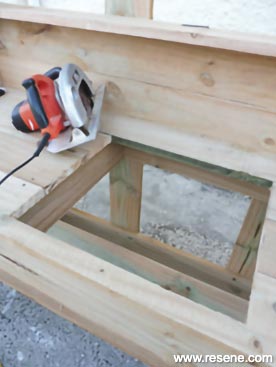 Step eleven
Step eleven
Measure, mark and cut a rectangular hole to fit the sink, ensuring that the back edge is one fence paling width from the splash back, as shown. Use the circular saw to carefully cut straight lines across the fence palings and finish off these cuts with the hand saw.
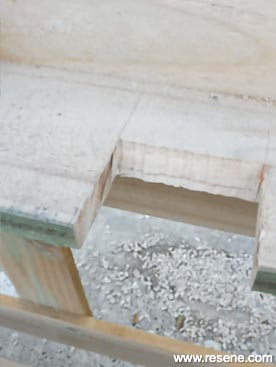 Step twelve
Step twelve
Cut a 100mm x 100mm section centrally at the back of this hole, as shown (use the jigsaw or circular saw for this).
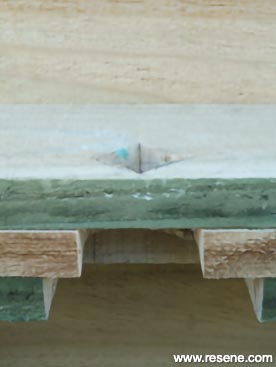 Step thirteen
Step thirteen
Take two of the offcuts from step eleven and cut holes, as shown, to accommodate the underside fittings of the tap (this will vary according to your tap). Fit these two pieces of wood along the back edge of the sink hole. Fix with 75mm screws.
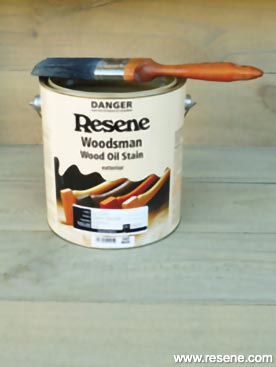 Step fourteen
Step fourteen
Apply two coats of Resene Woodsman tinted to Resene Uluru to the entire potting bench allowing 24 hours for each coat to dry. Clean paintbrush with turps.
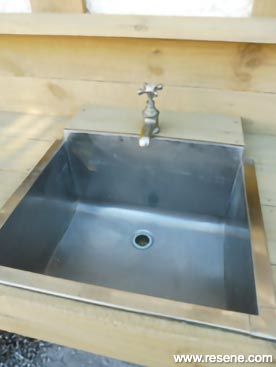 Step fifteen
Step fifteen
Unscrew the wastepipe from the sink and then fit the sink into position, as shown. Fit the tap into position using a spanner to tighten the large nut on the threaded underside. Screw the 20mm hose connector to the end of this threaded pipe and then connect the garden hose.
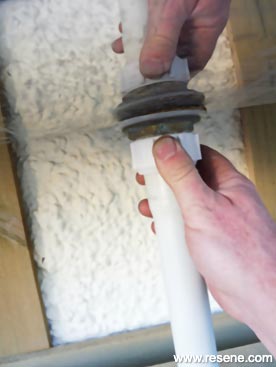 Step sixteen
Step sixteen
Measure, mark and cut the wastepipe to size (approx 320mm) and reattach to the underside of the sink as shown. Place the large plastic tub under this to catch waste water.
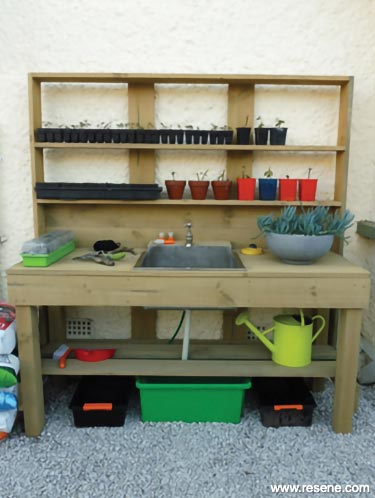
 Step one
Step one  Step two
Step two  Step three
Step three  Step four
Step four Step five
Step five  Step six
Step six  Step seven
Step seven  Step eight
Step eight  Step nine
Step nine Step ten
Step ten Step eleven
Step eleven Step twelve
Step twelve Step thirteen
Step thirteen Step fourteen
Step fourteen Step fifteen
Step fifteen Step sixteen
Step sixteen